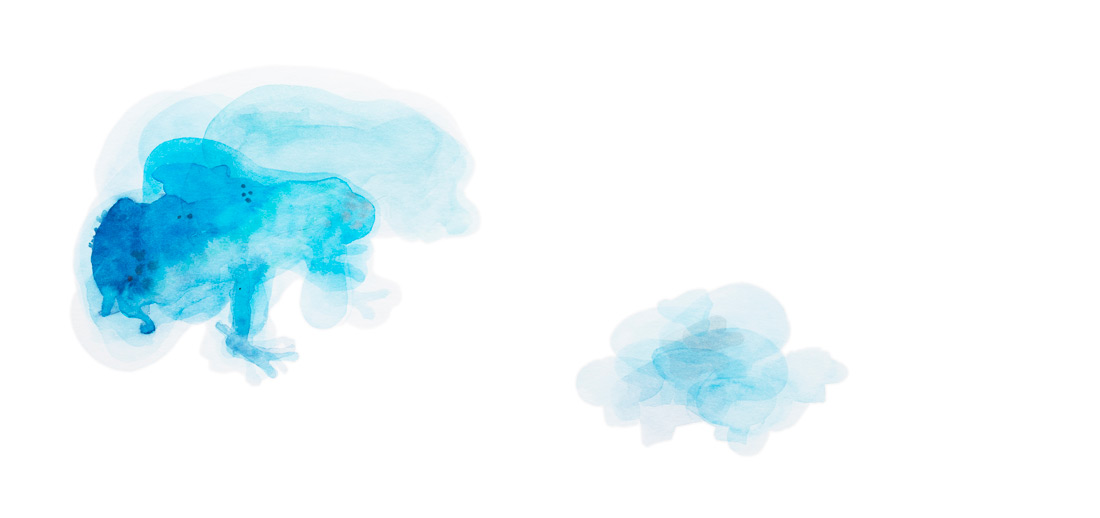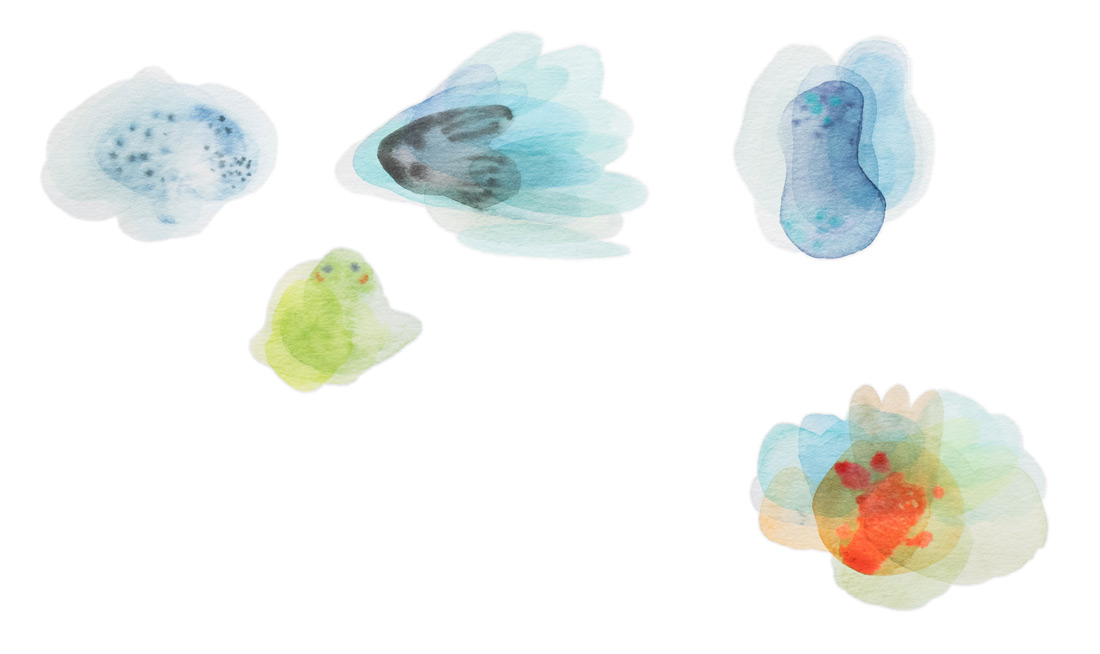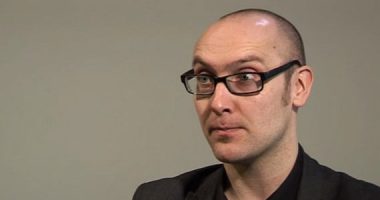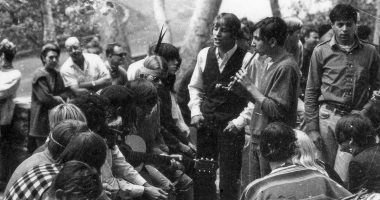
Adaptations from Study for Critters by Marija Avramovic from Xenoangel, 2020-21
A conversation between the artists Roc Jiménez de Cisneros and Serafín Álvarez, which starts with the problem of placing viruses (and other equally slippery entities) in the taxonomy of living organisms. An exchange on limits, classifications, synthesis and autonomy, but also a critical look at the multiple layers of anthropocentrism that permeate the way we think about the world.
Roc Jiménez de Cisneros (RJdC): Ever since the pandemic started, I’ve been batting about the idea of the status which we confer on (or allow) viruses in the world. That is, not so much how a virus works or what it does with respect to other organisms, but its category with respect to them – the position viruses occupy in the hierarchy of life. And the more or less official answer seems to be ‘none’: the prevailing consensus of the scientific community is that viruses are not alive. Obviously, they interact with living organisms, but, technically, they are not alive. Which seems kind of eccentric, to say the least.
Language is probably the most complex machine that most humans use throughout our lives. And it is this machine that transparently articulates and orders our reality. Often, expressing something collectively is enough to crystallise concepts that are not just statements, but mental, social and political structures (which in turn generate others, which in turn generate others, and so on). This capacity of language is as fascinating as it is dangerous, because we also use it constantly to generate structures that are questionable to say the least. Because although this complex machine is collective, it is certainly not horizontal – there’s a very well-defined hierarchy.
So, for example, the assertion that a virus isn’t alive because it’s a packet of RNA or DNA with no cells, and therefore needs to hijack the cellular machinery of other organisms in order to reproduce, seems to me to be one of those axioms which we can learn from. And even question.
Serafín Álvarez (S.Á.): I was also surprised to discover that, apparently, viruses are not considered to be a life form. Just like you, this discovery also made me ask myself questions about how language structures our reality – by the way, what did you mean when you said it does this transparently? The first thing I did was to ask myself which characteristic properties are needed for us to consider something to be alive. I tried to answer this question in my own words and based on my own knowledge, putting together a checklist of things that living organisms fulfil and that non-living entities don’t. I failed. When I tried to check how accurate the list was, I kept finding non-living things that possess several of the properties, and living things that don’t have all of them. The list I was trying to draw up kept unravelling, it was like trying to draw the edge of the sea on the sand, a line that’s blurred by each new wave. However, far from being frustrated by this failed attempt to identify how we determine when something is or isn’t alive, I found it extremely stimulating. In our everyday lives we usually find it very easy to look around us and distinguish between the things that are alive and those that aren’t, but any attempt to give a precise description of this difference involves cracking open a can of worms that contains an enormous well of complexity, and that puts to the test the very language we use to describe it.
Humberto Maturana and Francisco Varela, for example, tried to find a different way to answer this question, by looking not at the traditional list of properties but at a certain kind of dynamic organisation which, they say, characterises living beings, an organisation they describe as autopoiesis – the ability of a living being to produce itself. Although I don’t think this approach is infallible either.
Viruses lie at the limits of what we consider life, and I find those limits fascinating. In The Order of Things, Michel Foucault explains that life is a category of classification that didn’t exist until the end of the 18th century. Like all other categories, it’s relative to the criteria one adopts and its boundaries are movable – it’s impossible to define them with precision.

Adaptations from Study for Critters by Marija Avramovic from Xenoangel, 2020-21
RJdC: I used ‘transparent’ in the sense of ‘practically invisible’. Language is something that permeates most of our activities and is so ubiquitous and necessary that we often don’t notice it’s even there, or how much it shapes our understanding. A good example of this is protein folding, which is the process by which a protein folds itself into its three-dimensional structure. Occasionally one of these proteins folds into structures that are harmful to some species, such as ours. You remember mad cow disease, right? That’s essentially it. The disease is caused by prions, which are these proteins which our science labels as ‘misfolded’. Which seems to me a very harsh use of language. What do we mean by misfolded? Just because they aren’t optimal for our existence doesn’t mean they’re mis-folded. The optimal three-dimensional structure, on the other hand, is called the ‘native structure’, which also carries with it an almost biblical baggage. And if that weren’t enough, when one of these proteins loses its native structure, this is called ‘denaturation’ (which comes terribly close to equating what is natural with what is human). All these terms seem to tell us more about ourselves than they do about proteins. I find it pretentious to say that prions, the proteins that cause spongiform encephalopathies, do not work properly, are broken, glitchy or something like that. Obviously, they aren’t ideal for a lot of mammals, but prions work perfectly well. That’s what happens when we use language designed to talk about humans to talk about things so incredibly different from ourselves.
As you pointed out, the key issue here is thresholds. Without thresholds there’s no taxonomy, and the criteria in your quote from Foucault is the crucial point. The almost unanimous consensus in biology is that the presence of cells marks out the line for categorising living organisms. My question is whether this particular threshold is the most appropriate. A single-celled paramecium lies in the same category (not the same place in the hierarchy, although it is part of the ‘living’ subgroup) as a mammal with trillions of cells. Of course, I don’t mean to question whether single-celled organisms are alive. I simply propose re-examining how these thresholds affect specific cases such as viruses.
Because a virus is very different from a human, a basil plant or a dolphin, but so is a protozoan. So the door into the living organisms VIP area isn’t a matter of morphological difference, of physiology. I think that this doorway points at a whole load of more or less subtle prejudices that mean the notion of ‘life’ is defined according to extremely specific conditions – those points on the checklist that you mentioned: metabolising energy, growing, reproducing, etc., which make some sort of sense, but also seem to tilt the balance dangerously towards a clearly human phenomenology and physiology.
We happily accept that some animals and plants that have rather strange characteristics compared to our own are living things. Some insects, reptiles and sharks can reproduce without mating. The same is true of the Hydra, the millimetre-long hermaphrodite invertebrate predator that hunts by firing neurotoxins at its prey and appears to have no brain. Some species of starfish can regrow a severed limb. And a severed limb can sometimes develop a new central disk and new arms, resulting in a whole new starfish. Which is nothing like the way most mammals reproduce. Anyway, there is a long list of living organisms that function according to very different rules from those of our life cycle, but no one would think to suggest that these organisms are not alive because they are radically different from others. So it seems pretty arbitrary to state that a virus should be outside of this category because it has no cells. Couldn’t this be yet another one on this long list of exceptions that make up the diversity of living beings?
In this sense, Maturana and Varela’s approach is interesting because it does away with many of those preconditions and tries to bring it down to a lower level, thinking in terms of autonomy, relationships with the environment, exchanges of information with the environment or with other entities, as well as circular and reciprocal chains of mutual causality.

Adaptations from Study for Critters by Marija Avramovic from Xenoangel, 2020-21
S.Á.: The concept of autopoiesis is very interesting and fascinating, and much of its interest, in my view, lies in what you mentioned about trying to look at it from a lower level. Autopoiesis precedes reproduction or other points on the checklist when it comes to determining whether or not something is alive. That’s why viruses aren’t considered to be alive, because they don’t metabolise, they don’t maintain themselves autonomously, they are not, by themselves, autopoietic, they need to enter into an entity that is autopoietic, like a cell. What I want to say is that, I think, autopoiesis isn’t 100% infallible either when it comes to describing what a living being is, in the same way that no other definition can be completely infallible. And what I was saying is that this impossibility doesn’t make me lose heart, on the contrary, it excites me.
Again, it’s a question of limits. Talking about cells: most of the cells in our body aren’t human cells, they’re bacterial cells. But without them we couldn’t survive, we need them to maintain this self-organisation, so our bodies can function. We’re holobionts, we can’t draw a clear dividing line. If we consider a human being to be alive despite the fact that it depends on other smaller beings in order to achieve this, why have we decided that a virus isn’t alive because it depends on larger beings? I’m not trying to suggest that a virus is a living being, I’m simply, as you yourself propose, trying to question it and learn something in the process. What I’m trying to say is that it’s not always easy to determine where one organism ends and another begins, and it’s at this boundary where, I think, the concept of autopoiesis is not infallible, because it assumes a clearly distinguishable unity. Here we have an issue of scale, something that also fascinates me. We consider our body to be a unit, but if we look at it under the microscope, we see that the cells are separate self-organising units. Maturana and Varela proposed the cell as the limit, as the minimal autopoietic unit, but if we keep zooming in, we see that these cells are made up of molecules, that they’re made up of atoms, that they’re made up of subatomic particles, that they’re made up of even smaller particles… and there is self-organisation at all these levels. If instead of zooming in we zoom out, we have social systems, planets, galaxies, etc. Are an ecosystem, the planet Earth or the biosphere living beings? I’m no expert on the subject, but I’d say that, in theory, they meet the criteria of self-organisation and self-maintenance proposed for autopoiesis. Maturana and Varela weren’t sure, and they were reluctant for the concept to be adopted by other areas, such as the social sciences, but it’s certainly an interesting question.
RJdC: Very much so. And it’s a pity that it hasn’t really permeated into the collective consciousness. You know, if viruses are not considered to be alive, the idea of a galaxies as organisms seems far-fetched. Perhaps one of the main stumbling blocks in all this is that, as you pointed out in the case of Maturana and Varela, the notion of the cell has taken on too central a role in the way we see the world. Perhaps it’s this cell-centric thinking which, at least in the West, is the absolute norm, that relegates other views on life (self-organisation as life, for instance) to the level of fiction.
Viruses need the cells of other agents to reproduce, and this absence of cellular apparatus (or this more or less parasitic gesture) is the very thing that seems to disqualify them. Perhaps it would be more constructive to consider this exchange as one of the markers of life. Plants need light and nutrients from the soil, we need food, water, etc. They are very different patterns, but the principle is similar: we use other agents along the chain to maintain homeostasis through exchanges of energy.
The other bias you point out, that of scale, is also crucial in all this. If viruses were the size of dogs, orcas or octopuses, it would be harder to think that they are not living organisms. We’re conditioned to ignore extremely small things as if they had no right to life (we wouldn’t normally frown upon killing an insect as much as we would killing a whale). But in this case it goes well beyond that. It’s not even about their right to life, it’s a taxonomical right – they’re not even conceded the right to be considered alive. This exclusion from the category of the living has other interesting implications. When we claim that a virus is ‘not alive’, this surely doesn’t mean that it is ‘dead’. Rather, it means that it is in a kind of ontological limbo, neither alive nor dead. Which is very similar to the category we assign to certain mythological beings like vampires or zombies. The undead, the living dead, who also inhabit this completely hermetic ontological grey area. So, in this sense, according to the current consensus, viruses are also undead. And while I don’t agree with these thresholds, the taxonomy proposed by science means that, in some way, we’re surrounded by the undead even outside of our fiction.

Adaptations from Study for Critters by Marija Avramovic from Xenoangel, 2020-21
S.Á.: This analogy you propose is interesting, although there’s a fundamental difference. In general, the undead of mythology and fiction were alive before they turned into vampires/zombies/ghosts/etc., they lived and ‘didn’t completely die’, or they died and were ‘resurrected’, and this transformation is meaningful: the undead are always non-living in relation to a previous state in which they were alive. A virus, however, has had no such previous life, it’s born straight into this ontological limbo.
Speculating on the hypothetical relationship between viruses and the undead reminds me that in many zombie stories, the cause is a virus; for example in Resident Evil the thing that triggers the catastrophe is a virus created by a major pharmaceutical company as a biological weapon. This brings us to another interesting threshold of life: synthetic biology, the discipline that deals with creating life forms in vitro. In other words, life forms that are not born but rather designed and manufactured, for example bacteria with various applications. We were talking about how language constructs and shapes realities from an anthropocentric perspective, for example pointing out and describing what life is and what it is not, or deciding whether certain proteins are ‘misfolded’. But here we’re going further. It’s not just a question of labelling something as alive or not, but of creating it, of bringing it into the world. While before we said that the concept of life was a construct, here we are literally constructing organisms. The term ‘synthetic’ brings with it from the start a whole host of problems: we understand synthetic to mean something artificial, generally as opposed to something natural, which, depending on the context, on who assesses it and when, can have negative connotations – something ‘fake’, something that tries to pass itself off as something else, etc., for example cultured meat, which is unnatural meat, which is not real meat, etc.; but can also have positive connotations – something that reproduces something else by improving it (I must stress the context, of course there is no universal better), whether at the qualitative level, economical level, etc. For example, cultured meat again, which would reduce the slaughter of animals for meat consumption and which would allow the control of nutrients. Is a synthesised autopoietic organism alive? Is it possible to design life forms? What ethical implications would this entail?
RJdC: I get your point about the undead, but there’s something that really interests me in my original analogy, and it has to do with how the figure of the zombie has evolved over the years. From Haitian mythology and folklore, through the Western hyper-racist bias (the zombie as something exotic, the foreigner, the infidel, etc.), zombies have gradually been resituated within the context of the global environmental crisis, and as you pointed out, today they’re related more to these kinds of narratives (failed experiments, pandemics). What I find curious is how the two notions have become aligned in a kind of metonymic relationship: the fictional one, in which zombies are the product of a viral pandemic, and that of viruses as something that could appear to be alive, but aren’t. Indeed, more than being dead, zombies exist in an altered mental and physiological state that defies biological and social norms. And this layer of morality doesn’t differ much from the morality that leads us to push viruses into limbo.
As for synthetic life, the answer depends on what you consider ‘engineered’ life. This is more or less what agriculture is, I suppose. But there are even recent examples of synthetic life in a more literal sense, like those E.coli specimens created a few years ago with a 100% synthetic genome. Again, it’s a linguistic and moral problem, I think. We are still determined to equate ‘synthetic’ to ‘artificial’, as opposed to what is ‘natural’ (which is such a problematic term).
The meaning ‘synthesis’ takes in chemistry, that of a combination of reactions, is consistent with its Greek roots, far from the connotation of ‘aberrant’ or ‘fake’. I often refer to Robert Moog’s approach. He was one of the founding fathers of musical synthesizers, and he named his machine thinking more of its Greek roots than the idea of artificiality that is still prevalent today. In the 2004 documentary about his life and work, Moog said: “Around 1967 (…) we thought of the process of making the sounds as putting the parts together, which is what ‘synthesize’ means: to put together something whole out of all of its parts. And that’s when we decided to use the word synthesizer. (…) We didn’t mean to imply that what it made were synthetic sounds – they were synthesized sounds. They weren’t fake anything, they were real synthesized sounds.”
Just like the bacteria synthesised in a UK lab aren’t ‘fake’, but completely real, even though they are synthesised. Synthesis merely as a combination of parts is important in relation, for example, to what you mentioned at the beginning about how our bodies are partly made up of non-human bacterial cells. In this sense all life is synthetic, the result of combinations.

Adaptations from Study for Critters by Marija Avramovic from Xenoangel, 2020-21
S.Á.: Indeed, the concept of ‘natural’ is intricate, the very idea of nature is an artifice. The video Nature from A Vocabulary for the Future at the CCCB, by Gerard Ortín Castellví and Bruno Latour, questions the boundary between what we understand as natural and what we understand as cultural, affirming that it is an opposition that we use as a moral criterion. In a similar way to how you claim that, in a certain sense, all life is synthetic – understanding synthesis as the process of creating something from its parts, Latour states that, in a certain sense, everything on Earth is artificial, since everything has been ‘designed’ by some form of life – a city is produced by human action in a similar way to how oxygen is produced by cyanobacteria.
In the binomials of natural/artificial, nature/culture, etc., we encounter head-on what you explained at the beginning of this conversation about how language orders our reality, generating an important structure on which we establish a multitude of aspects of our life.
The same applies to the concept of synthesis. If we were to trace the history of its meanings, we would see that it’s a multifaceted and slippery term, which is what Sophia Roost does in the interludes of Synthetic: How Life Got Made. The thinking you explained behind the name synthesizer is interesting, but, although this is contrary to what Moog intended, it’s true that the idea of synthesising sound as a process of mimesis or imitation of something ‘real’ is indeed deeply rooted and often connotes falsity and artificiality. In fact, many of those who first used them avoided referring to their instruments as ‘synthesizers’ to avoid these connotations. Be that as it may, it’s interesting to consider this way of understanding synthesis in relation to its Greek etymological root, not as the imitation of something that already exists but as the construction of something new from the combination of its parts. It lets us see things from a different perspective.
It reminds me of xenobots, a… new life form? created in 2020. Xenobots are designed by a computer and made by human hands. The computer creates a digital organism using a random configuration of cells and tests the organism’s ability to perform a given task, such as moving around. It repeats this operation thousands of times, generating thousands of virtual organisms, each of them with a different random configuration of cells, and selects those that are best suited to the task, for example, those that are able to move the furthest. Human scientists then manufacture these organisms in a laboratory using biological tissues, reproducing the ‘best’ digitally simulated cell configurations with animal cells. The interactions between the resulting organisms generate unexpected behaviours, such as multiplying or working together as a team. Projects like this undoubtedly call into question the limits of life that we’ve talked about throughout our conversation. I’m not saying that xenobots are living beings, but they certainly throw into question what we understand by life.
At the beginning we quoted Foucault to say that life is a category that didn’t exist before the 18th century, and now we might venture to say that, as such, it may have ceased to exist at the end of the 20th century. Let’s see what forms of life, and what re-definitions, the 21st century has in store.






Leave a comment